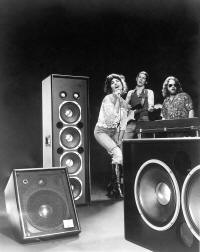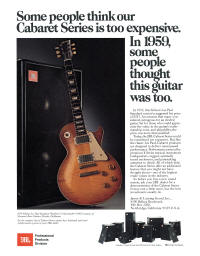|
|
The Cabaret ® Series is widely credited as being the first
full line of portable PA systems for the musician and music store market. It
established a market segment that has grown to be the largest of those
addressed by JBL Professional's five product divisions. The inspiration and
drive to see through their development, came from JBL's current Vice
President of Marketing – Mark Gander. The following is his account of this
series' history and market impact.
The series began as result of a number of
product requests which had been kicking around the JBL Engineering
Department throughout the mid-1970s, and because of my personal particular
interests in the product area and customer applications, I took it and
championed it through development to fruition in production.
It was initially directed at the MI
(Musical Instrument) store musician market, what we now refer to as Portable
PA as opposed to high-end Tour Sound. The first three products were:
-
Model 4680 – a wood version of the previous model 4682
thermoplastic "Strongbox" with four-K110 10" in a line array and dual
2402 bullets (how interesting that the modern version of line arrays are
now all the rage in sound reinforcement!);
-
Model 4622 – a dual-12" K120-8 guitar cabinet;
-
Model 4602 – a 12" K120-8 with 2402 bullet floor monitor, the multi-faceted shape of which I conceived
of and created.
|

Original Cabaret
Series
4602, 4680, 4622
© Harman International,
Courtesy
Mark Gander
|
I presented a Feasibility Study for the
line in July, 1978. Doug Warner of Warner Design Associates, former
partner/understudy to Arnold Wolf, contributed design study renderings.
Distinguishing elements included specially tooled stacking corners and
optional, flush-fitting protective transport covers. I located 3M "Hedlock"
mating fasteners for the covers, and also located spring-loaded cover caps
for the 1/4" phone plug input jacks to prevent air leakage. I developed a
special metal handle with the J. H. Sessions case hardware company with
thick rubber on the movable bail that both improved handling strain and
damped vibration noises. The enclosures were first manufactured of
industry-standard cross-laminated Baltic or Finland birch. Later we
developed our own special maple-faced poplar which had an even better
strength-to-weight ratio.
The product line was launched at the
summer NAMM show in Chicago in June 1979. You can see me posing with the
first three products, and a fourth that was the format for next additions to
come, single 15" variants in the same rectangular enclosure as the 4622,
outside next to the old engineering labs on the north side of the Northridge
8500 building.
By the end of the year, the ferrite
conversion of JBL cone transducers was taking place, and "A" versions of
these systems were introduced using E-Series SFG (Symmetrical Field
Geometry) models in place of the K-Series Alnico models. Later, as the
ferrite conversion followed through on the compression drivers and ring
radiator tweeters, those substitution upgrades were made and the Cabaret
models became "B" versions.
|

Ad for the 1982
Cabaret Series
© Harman International,
Courtesy
Mark Gander
|
The next additions were a number of models
in the same rectangular enclosure: the 4621 with a single E130-8 for lead
guitar; an acoustic guitar and vocal system, the 4623, which added a 2402
bullet and high-pass network with L-pad level control to the 4621; and the
4625 with a single E140-8 for bass; and a two-way keyboard system, the 4627,
with a E145-8 and the 2901A High-Frequency Power Pack, a 2410 compression
driver on the 2301 perforated-plate horn-lens with a high-pass network. A
double-size, rectangular 10 cubic-foot enclosure for a E155 18" for bass
guitar was also introduced, the 4695. These were introduced along with a
full line brochure at the January 1980 Anaheim, CA NAMM Winter Market show.
When I moved from Engineering into the Pro
Division Marketing department in 1980, I developed the introduction plan and
marketing materials to promote the line, and defined the product additions
that expanded its offerings. I was aware that there was a latent demand for
better performing and more portable sound reinforcement systems, and that
this product area had much greater potential than merely providing premium
speaker cabinets for musical instrument amps. My first position in Marketing
was that of Applications Engineer, and one of my first contributions was to
generate a JBL Applications Note "Applications of JBL Cabaret Series as
Modular Sound Systems." Influenced by the Grateful Dead's "Wall of Sound"
modular system as well as other professional touring system packages of the
1970s, I showed how the building blocks provided by the various Cabaret
Series elements could be configured into small PA and line array
configurations as well as musical instrument systems, all of which could
both be flexibly assembled as well as grow with the customer's needs.
In June of 1980 the first real two-way PA
speaker was released, the 4690, with an E140-8 and a 2410 compression driver
on the only compact horn available at the time, a brushed aluminum version
of the 2307 called a 2306. In addition to its place in the basic Cabaret
line and brochure, a special brochure was developed to promote the 4690
together with the 4695 as a portable disco system.
|

Introduction of 4612 at
1982 Summer NAMM
© Harman International,
Courtesy
Mark Gander
|
The success of the Cabaret Series and the
burgeoning musician and portable sound reinforcement market in general meant
there was demand for more compact high-quality system packages. In 1982, I
conceived of a small configuration which would mimic the look of the large
JBL 4350 and 4435 Studio Monitors and other similar systems, with two
woofers side by side and a horn above. Don Keele's presence at JBL came into
play, he having developed the 100-degree-by-100-degree-coverage Bi-Radial
Horn concept for the 4430 and 4435 Bi-Radial Studio Monitors, and
subsequently miniaturizing of the horn to mount on the ring-radiator motor
and phasing plug assembly with 1/2-inch exit, first developed for the 2403
elliptical-mouth tweeter in the L220 hi-fi system. This new 2404 tweeter, in
a "-1" version with the 2402 diaphragm in place of the 2405 diaphragm for
lower crossover-point usage, coupled with two new 2118 8" drivers, became
the 4612 Cabaret Series Mini-P.A. System, first introduced at the Atlanta
Summer NAMM Show in June 1982. It was an incredible market success, combing
visual appeal and high-fidelity performance at an attractive, affordable
price point. A permanent installation version was developed in oak vinyl,
including integral mounting points. David Smith, who also worked with Don
Keele on the Bi-Radial Studio Monitors, was the system engineer on the 4612.
With the availability of these parts, in
1983 the 4627 two-way Keyboard/Reinforcement system was upgraded and super
seceded by a three-way model, the 4628, which used the 2404 and one of the
2118 8" as a midrange with the E145-8 woofer. Dean Rivera was the system
engineer on this and other later Cabaret Series models.
Don Keele had created the small versions
of the large Bi-Radial® Constant Coverage horns with flat fronts at my
suggestion to allow them greater utility in packaged systems, and the 4690
was super seceded later in 1983 with the 4691 which substituted the 2370
Flat-Front Bi-Radial horn. This constant directivity horn design, Constant
Coverage as JBL called them, made the 4691 the most popular and most
versatile of the Cabaret Series systems. In 1985 a floor monitor version was
made, the 4604, slicing off the lower rear of the enclosure to create an
appropriate angle for monitor use.
As the packaged PA system success of the
line broadened and was more fully recognized, more system variants were
developed. Later in 1985 the big 4695 18" was transformed into two
full-range systems: the 4698 Keyboard/Electronic Drum/Reinforcement System
with an E110-8 10" midrange and a 2404H-1 tweeter, and the 4699 Full Range
Playback/Reinforcement System with the same E110-8 as a midrange and the
same high-frequency horn and driver from the now 4691B, the 2425J ferrite
compression driver and 2370A ("A" here designating a re-tooled high-volume
version) Flat-Front Bi-Radial Horn. Optional casters were available to aid
in the portability of these huge systems.
The Cabaret Series product line's success
and longevity was exhibited by not only musician PA and musical instrument
use, but many clubs, churches and other permanent installation applications
choose the products in the 1980s developmental years of pro audio installed
sound contracting.
The line lasted until 1991 when it was
ultimately replaced by the SR and MR Series, which had a more pro-audio and
more portable appearance and performance, but it is still remembered fondly
by many and some units can even be still found in service around the world.
As a footnote, the name was revived for use on a special PA product line for
the Sam Ash stores in the 1990s, and JBL still holds the registered
trademark on Cabaret® for loudspeakers.
© Mark Gander, June 2006
|
|